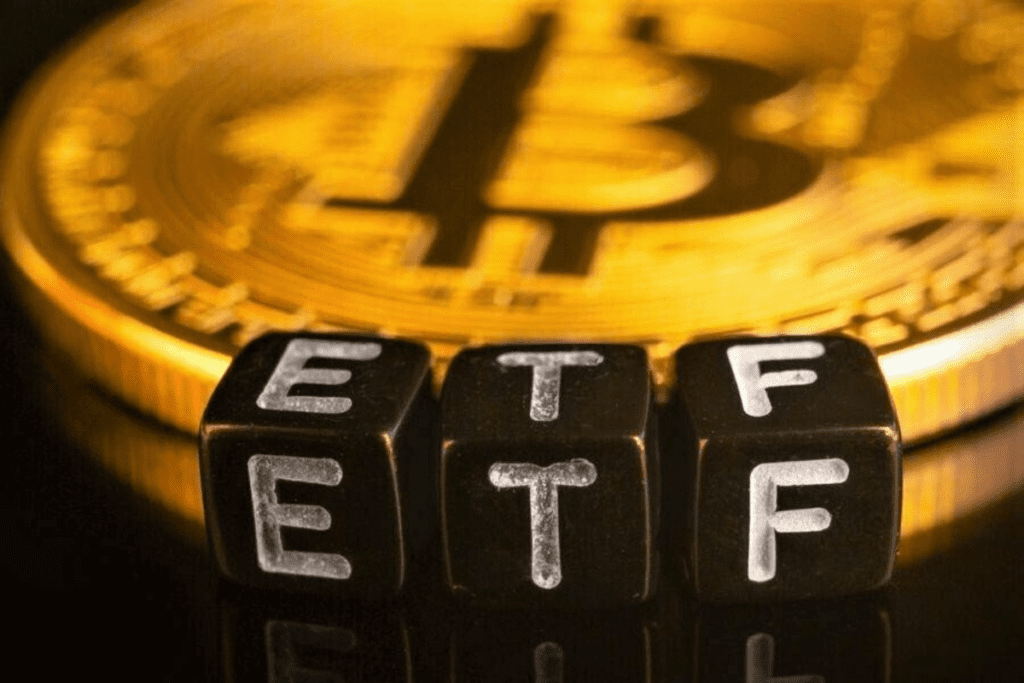Bitcoin Spot ETF vs Futures ETF: Differences To Make The Right Investment Choice
The key differences between Bitcoin Spot ETF vs Futures ETF come from the issuance purpose and investment method of each type of ETF. Today, let’s learn about Bitcoin Spot ETF vs Futures ETF with Coincu through this article.

Overview of Bitcoin ETF market
The cryptocurrency market is a relatively nascent and dynamic space, driven by the ever-increasing demand for Bitcoin. Bitcoin, the world’s first and largest cryptocurrency, made its debut in 2009, leveraging groundbreaking blockchain technology.
Much like gold, Bitcoin is characterized by its limited supply, capped at 21 million BTC, with the final coins expected to be fully mined by 2140. These similarities have led many to draw parallels between gold and Bitcoin, dubbing the latter “digital gold.”
One significant development in response to the surging demand for Bitcoin is the rise of cryptocurrency ETFs, particularly Bitcoin ETFs. These financial instruments have gained considerable momentum and popularity, offering an alternative way for investors to gain exposure to Bitcoin without the need to engage with cryptocurrency exchanges or directly hold BTC. Instead, Bitcoin ETFs track the digital token’s value, which can be measured using either the spot price or futures price.
Unlike Bitcoin itself, these cryptocurrency ETFs are traded on regulated market exchanges, making them more accessible to traditional investors.
What is a Spot Bitcoin ETF?
A Bitcoin Spot Exchange-Traded Fund (ETF) is an investment vehicle that enables ordinary investors to gain exposure to the price fluctuations of Bitcoin in their regular brokerage accounts. This innovative approach streamlines the investment process, allowing individuals to participate in the Bitcoin market without the need to acquire and manage the actual cryptocurrency or deal with complex crypto wallets.
One of the most significant advantages of Bitcoin spot ETFs is that they provide a regulated and accessible means for mainstream investors to invest in the digital currency. Investors can access the cryptocurrency market through their regular brokerage accounts, avoiding the need to sign up for cryptocurrency exchanges or handle digital wallets.
While Bitcoin spot ETFs come with management fees and brokerage commissions, these costs are offset by the savings in time and exchange fees that would be required to buy and securely store Bitcoin directly.
In traditional investing, ETFs are a common form of investment that track the price of a single asset or a diversified portfolio of assets. They offer investors a straightforward way to gain exposure to multiple assets simultaneously without the need to own those assets physically. In the context of Bitcoin, a Bitcoin ETF is essentially an asset that mirrors the price movements of the cryptocurrency.

By investing in a Bitcoin ETF, investors can still benefit from Bitcoin’s price appreciation without going through the intricacies of acquiring and managing Bitcoin themselves, including the account setup and verification process on cryptocurrency exchanges.
It’s important to note that the concept of Bitcoin ETFs is still relatively nascent. The first Bitcoin ETF, known as the ProShares Bitcoin Strategy ETF (BITO), was launched in October 2021. However, it’s worth highlighting that BITO, unlike traditional Bitcoin spot ETFs, does not directly invest in the digital asset.
Instead, it utilizes Bitcoin futures contracts as an alternative investment strategy. This distinction has sparked discussions within the crypto community regarding the true nature of Bitcoin ETFs and their potential for mainstream adoption.
What is a Futures Bitcoin ETF?
Futures Bitcoin ETFs, unlike traditional cryptocurrency exchanges, are pools of bitcoin-related assets traded on conventional exchanges by brokerages. These funds are composed of assets closely linked to the price of Bitcoin and have gained widespread attention as an alternative means of cryptocurrency investment.
The cornerstone of these ETFs is the use of futures Bitcoin contracts, which are actively traded on the Chicago Mercantile Exchange (CME). A futures contract is a standardized agreement between two parties to exchange a specific quantity of assets on a predetermined date at a specified price. These contracts are the building blocks for futures Bitcoin ETFs.
To create a futures Bitcoin ETF, companies purchase these futures contracts from the CME Group and assemble them into a fund. This fund is then made available to investors on traditional exchanges. One distinctive feature of these ETFs is that the futures contracts within the fund are actively managed, allowing for flexibility and optimization.
The genesis of futures Bitcoin ETFs can be traced back to a period when Bitcoin’s price began its meteoric rise and garnered significant interest among investors. As the price of Bitcoin soared into the tens of thousands of dollars, many retail and average investors found it challenging to invest directly in the cryptocurrency. In response to the growing demand for Bitcoin exposure, brokerages began conceptualizing Bitcoin exchange-traded funds. The first applications for approval from the Securities and Exchange Commission (SEC) were filed in 2013, notably by the Winklevoss brothers.

In a conventional exchange-traded fund that tracks stocks, the fund acquires the underlying stocks, and these stocks become the fund’s holdings. Fractionalized shares of the fund are then offered on exchanges, providing investors with access to the assets. These ETFs trade almost round the clock, 24 hours a day, seven days a week.
While many crypto enthusiasts envisioned a Bitcoin ETF consisting of actual Bitcoin purchased by a company, securitized, and offered as shares to investors, the SEC consistently rejected such proposals. However, recent developments have set the stage for potential change. A court order has compelled the SEC to reconsider these proposals, and experts are increasingly optimistic that the first true Bitcoin ETF may receive approval in the near future.
Differencies Between Bitcoin Spot ETF vs Futures ETF
Bitcoin Spot ETFs: Direct Ownership of Bitcoin
Bitcoin spot ETFs, at their core, hold actual Bitcoin in custody. When an investor acquires shares in a Bitcoin spot ETF, the ETF provider undertakes the purchase of an equivalent amount of Bitcoin from the open market and adds it to its holdings. Conversely, when investors sell their shares, the ETF provider sells an equivalent amount of Bitcoin from its holdings. This buy-and-sell mechanism primarily comes into play during periodic rebalancing of the ETF. The salient feature of Bitcoin spot ETFs is their direct reflection of Bitcoin’s current market price, making them a reliable instrument for investors looking to track Bitcoin’s price fluctuations.
One of the notable advantages of investing in a Bitcoin spot ETF is the seamless exposure it provides to Bitcoin’s price movements, sans the hassle of managing or storing the cryptocurrency. This eliminates concerns related to security and digital wallet management. Furthermore, these ETFs trade on traditional stock exchanges, thus subjecting Bitcoin to regulatory oversight, potentially enhancing trust among a broader audience. Additionally, Bitcoin spot ETFs operate within the familiar structure of stock trading, making them more accessible for traditional investors.
Nonetheless, like any investment, Bitcoin spot ETFs carry their fair share of potential risks. The value of a Bitcoin spot ETF is inherently linked to the volatile price of Bitcoin. Moreover, it may not always perfectly mirror Bitcoin’s performance due to fees or administrative intricacies. While ETFs introduce Bitcoin to the world of traditional finance and regulatory scrutiny, the broader cryptocurrency market remains inherently unpredictable. Investors must also consider that ETFs tend to be more expensive to trade compared to spot crypto, due to additional fees that could reach as high as 2.5%, in contrast to the typically lower fees associated with spot crypto trading.
Bitcoin Futures ETFs: A Different Perspective
Bitcoin futures ETFs, in contrast, do not hold Bitcoin directly. Instead, they allow investors to participate in Bitcoin futures contracts, which are agreements to buy or sell Bitcoin at predetermined prices on specific future dates. The value of these ETFs is influenced not only by Bitcoin’s current spot price but also by market expectations regarding its future price, which can result in the futures ETF price diverging from the spot price. Futures ETFs provide more flexibility, allowing investors to take short positions on Bitcoin.
It’s important to recognize that Bitcoin futures ETFs bring a distinct set of benefits and risks to the table. The inherent nature of futures contracts introduces an element of speculation, as their value depends not just on the current Bitcoin price but also on market sentiment and future price predictions. The ability to short Bitcoin within a futures ETF can be advantageous for investors looking to profit from price declines.
Bitcoin Futures ETF List
Currently, there are three Bitcoin futures ETFs available on the market: BITO, BTF, and XBTF. The choice of which ETF to invest in ultimately depends on the preferences and needs of the user, considering that these ETFs are listed on different exchanges, each with varying rates.
ProShares BITO Bitcoin Futures ETF, standing as one of the prominent players in this space, boasts approximately $1 billion in investments. BITO finds its listing on the New York Stock Exchange (NYSE Arca), making it easily accessible to traders and investors.
Valkyrie Bitcoin Strategy ETF joins the fray, also providing exposure to Bitcoin futures ETFs. This ETF is listed on the Nasdaq exchange under the BTF ticker symbol. Investors interested in diversifying their portfolios have the option to consider BTF.
The VanEck Bitcoin Strategy ETF rounds off the trio. This ETF, listed under the ticker symbol XBTF, offers users a gateway to Bitcoin futures ETFs. The VanEck Bitcoin Strategy ETF is listed on the CBOE exchange, presenting another avenue for investors to tap into the Bitcoin futures market.

Conclusion
In summary, the choice between a Bitcoin spot ETF vs futures ETF depends on an investor’s specific goals, risk tolerance, and market outlook. While spot ETFs provide direct ownership of Bitcoin and a more straightforward investment approach, futures ETFs offer greater flexibility and the potential for both long and short positions. Understanding the differences and weighing the advantages and drawbacks of each can empower investors to make informed decisions in the dynamic world of cryptocurrency investment.
DISCLAIMER: The information on this website is provided as general market commentary and does not constitute investment advice. We encourage you to do your own research before investing.























